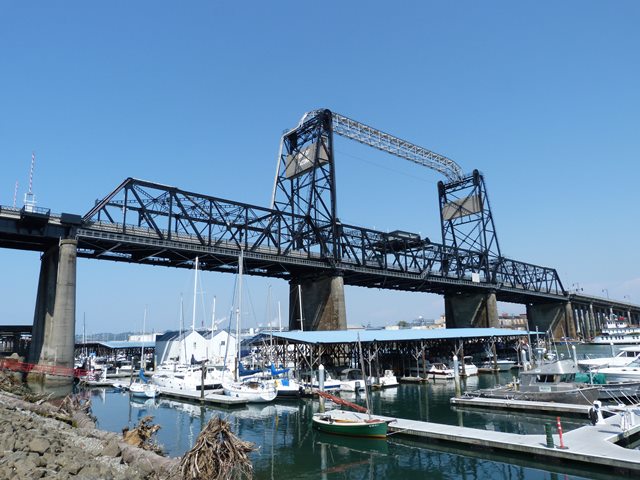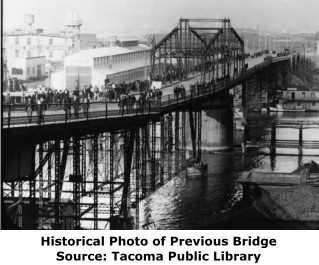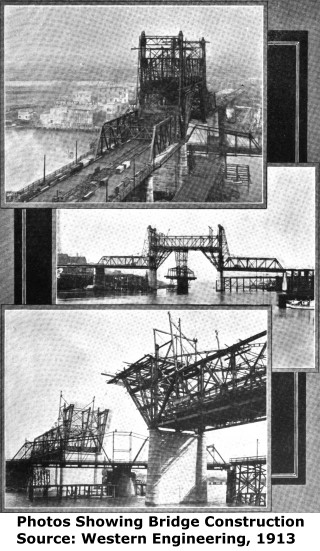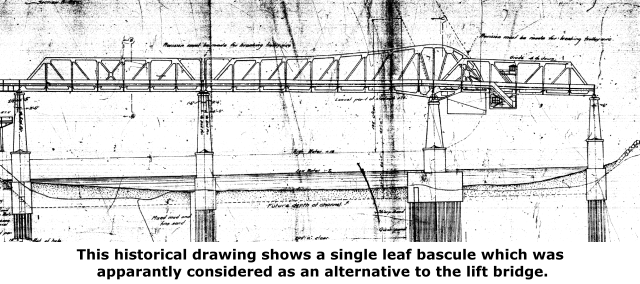We Recommend:
Bach Steel - Experts at historic truss bridge restoration.
BridgeHunter.com Phase 1 is released to the public! - Visit Now
Murray Morgan Bridge
11th Street Bridge

Primary Photographer(s): Nathan Holth
Bridge Documented: August 24, 2014
Tacoma: Pierce County, Washington: United States
Metal 8 Panel Rivet-Connected Pratt Through Truss, Movable: Vertical Lift (Span Drive) and Approach Spans: Metal 7 Panel Rivet-Connected Pratt Through Truss, Fixed
1911 By Builder/Contractor: American Bridge Company of New York, New York and Engineer/Design: Waddell and Harrington of Kansas City, Missouri
1957
34.0 Feet (10.4 Meters)
1,748.0 Feet (532.8 Meters)
34 Feet (10.36 Meters)
1 Main Span(s) and 21 Approach Span(s)
0005452A0000000

View Information About HSR Ratings
Bridge Documentation
View Archived National Bridge Inventory Report - Has Additional Details and Evaluation
View Historic American Engineering Record (HAER) Documentation For This Bridge
HAER Drawings, PDF - HAER Data Pages, PDF
View Historic Structure Reports For This Bridge
View Historical Articles About This Bridge
View The Fowler Patent Used For This Bridge's Piers

About This Bridge
This is a large vertical lift bridge. It was designed by famous firm Waddell and Harrington which was a strong advocate of vertical lift bridges, as opposed to swing and bascule bridges. Interestingly, a bascule bridge was considered here at 11th Street, but the lift design was selected instead. The bridge replaced a metal truss swing bridge. Portions of this previous bridge's pier remain at the western bank of the waterway, quite amazing considering the bridge has been gone for over 100 years. When the lift bridge was built the approach for the swing bridge was removed, a temporary approach was constructed to run at an angle, and the swing bridge turned slightly to serve this temporary crossing, making room for the lift bridge to be built in the original location of the swing bridge approaches.
When completed, this bridge was noted for its size and also for its notable four percent grade, which was rare for a lift bridge, and some sources report it was the first such example. Another unusual detail was the truss that ran from the two tops of the towers and was originally designed to carry pipelines. The overhead truss seen today is a replacement and not original.
The western approach of the bridge also originally had a ramp that connected 11th Street down to the waterway level. This ramp is long-gone, but portions of the ramp superstructure remain in place, integrated with the approach bents.
American Bridge Company fabricated the machinery and steel for the bridge, while International Contract Company of Seattle erected the substructure and superstructure on site.
The eastern approach for the bridge was originally timber trestle, and this was replaced with a concrete approach many years ago.
The bridge was originally called the 11th Street Bridge or the City Waterway Bridge. The bridge was renamed to Murray Morgan Bridge, and the waterway was renamed to Thea Foss Waterway. The Tacoma Public Library provided the following background on Murray Morgan:
There are many reasons why the 11th Street Bridge was renamed to honor Murray Morgan. That he was the bridge tender in his early thirties is part of the reason, but it is not the only reason. Like the bridge itself, both were central to the story of Tacoma's development. He was born in Tacoma three years after the 11th Street Bridge was constructed and died here in 2000, three years after it was named in his honor. Both symbolized urban life and the city's history. For many years, the bridge was the only non-rail transportation link between Tacoma and the port-industrial area. Its crossing over the Thea Foss Waterway was a constant hub of activity. So too was Murray Morgan's writings, journalism, and teaching a hub of activity over the years as he reported on City Council meetings and wrote his own history of Tacoma.
A Preservation Success Story
This bridge was for many years at risk for demolition and even was closed to traffic due to deterioration in 2007. Some even argued that the bridge should be torn down and not even replaced! However, an organized effort that went back to at least 2003 eventually led to the rehabilitation and preservation of this significant and iconic historic bridge in 2012-2013. The preservation of a bridge of such size and in the face of considerable opposition is a major success story for preservation. With the rehabilitation completed, it is hard to imagine why anyone would ever have suggested the bridge needed to be demolished. The bridge is today in great condition, and the historic integrity of the bridge was not seriously harmed during rehabilitation, meaning the bridge retains most of its original materials and design. A few specific postive notes about the rehabilitation deserve to be recognized specifically as follows. First, the main sheaves were replaced as was a lot of the machinery and gearing. The original gears and sheaves have been preserved as a display under the western approach of the bridge. This display not only preserved important original parts of the bridge, it also allows for visitors to see important parts of the bridge that normally would not be accessible or visible to the public. Also, the bridge originally had an unusual winding ramp that led 11th Street down to the water level. This deck and portions of the ramp no longer exist, but many of the girder spans and deck stringers are left in place, which is important because it makes it easy for visitors to see what once was here, and it also retains the aspects of the ramp which had engineering significance, notably how they are integrated into the bents which support the main deck. Another important element of the rehabilitation is that original lattice railings were not removed from the bridge.
The only major alterations noted to the bridge, and both appear to predate the demolition-avoiding rehab of 2012, is that the overhead pipe truss is a replacement of the original, and the removal of the portions of the western ramp.
This bridge makes an interesting comparison to the Columbus Road Bridge in Cleveland, Ohio. The Columbus Road Bridge was built decades later in 1940, but is another rare example of a lift bridge built with a notable grade. Ironically, although the Columbus Road Bridge was much younger than the Murray Morgan Bridge, Cleveland chose to demolish and scrap the entire lift span which was replaced with a modern lift span with key details changed such that it does not match or replicate the original span. As such, while both the Columbus Road Bridge and the Murray Morgan Bridge look "like new" as of 2014, the Columbus Road Bridge is so severely altered that it has lost all historic significance, while in contrast the Murray Morgan Bridge enjoys good historic integrity and remains a highly significant historic bridge... an outstanding preservation success story.
![]()
Photo Galleries and Videos: Murray Morgan Bridge
Bridge Photo-Documentation
Original / Full Size PhotosA collection of overview and detail photos. This gallery offers photos in the highest available resolution and file size in a touch-friendly popup viewer.
Alternatively, Browse Without Using Viewer
![]()
Bridge Photo-Documentation
Mobile Optimized PhotosA collection of overview and detail photos. This gallery features data-friendly, fast-loading photos in a touch-friendly popup viewer.
Alternatively, Browse Without Using Viewer
![]()
Maps and Links: Murray Morgan Bridge
Coordinates (Latitude, Longitude):
Search For Additional Bridge Listings:
Bridgehunter.com: View listed bridges within 0.5 miles (0.8 kilometers) of this bridge.
Bridgehunter.com: View listed bridges within 10 miles (16 kilometers) of this bridge.
Additional Maps:
Google Streetview (If Available)
GeoHack (Additional Links and Coordinates)
Apple Maps (Via DuckDuckGo Search)
Apple Maps (Apple devices only)
Android: Open Location In Your Map or GPS App
Flickr Gallery (Find Nearby Photos)
Wikimedia Commons (Find Nearby Photos)
Directions Via Sygic For Android
Directions Via Sygic For iOS and Android Dolphin Browser
USGS National Map (United States Only)
Historical USGS Topo Maps (United States Only)
Historic Aerials (United States Only)
CalTopo Maps (United States Only)






